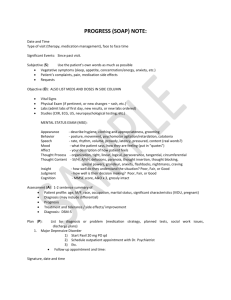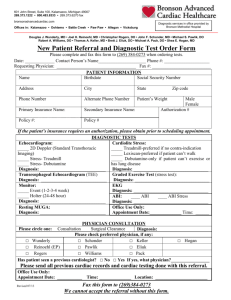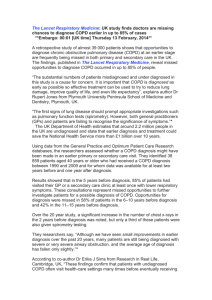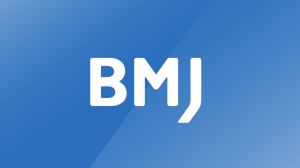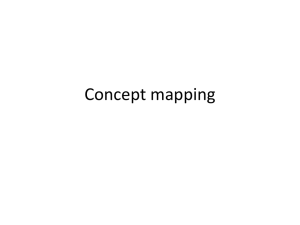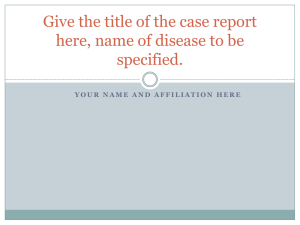Coding
advertisement
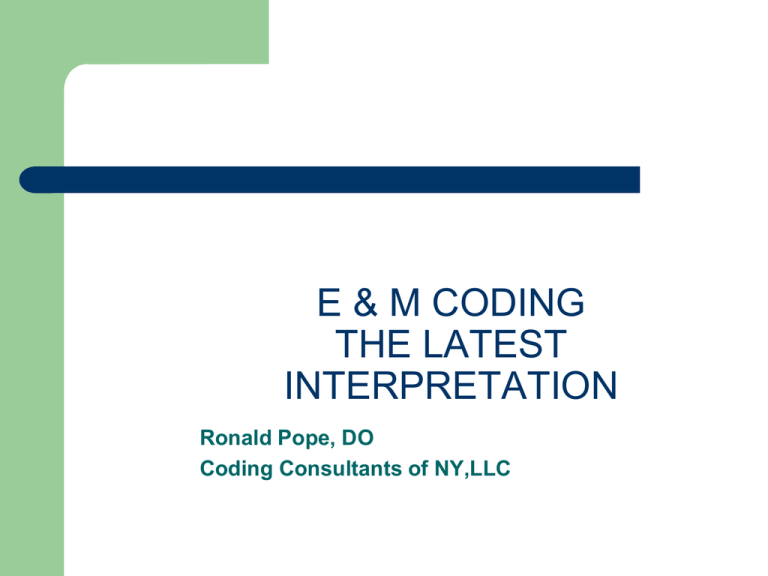
E & M CODING THE LATEST INTERPRETATION Ronald Pope, DO Coding Consultants of NY,LLC QUICK OVERVIEW Choose Level of service for Hx, PE, and Decision Making For Established patients pick the middle level For New patient’s choose the lowest of the three Despite the levels on all three sections, you can never bill higher than your Decision Making level HISTORY We will not focus on this too much Key points: For a 99214 you only need a ROS with 2 different systems Soc Hx or PMH or FamHx only one item needed Refer to the handout for proper Hx coding PHYSICAL EXAM 1995 Guidelines 8 Systems = highest level of service – – – – – – General ENT CV GU Musculoskeletal Lymph - Eyes Resp GI Derm Psych Neuro MEDICAL DECISION MAKING 3 Components, each coded separately Take the middle level of service – – – Diagnosis Data Risk DIAGNOSIS Based upon a point system – – – – 4 points = High Complexity (99215) 3 points = Moderate Complexity (99214) 2 points = Low Complexity (99213) 1 point = Straightforward (99212) There are two separate ways to calculate the points DIAGNOSIS-METHOD I (NUMBER OF DX) 1 Point: for each new or established problem for which the diagnosis and/or treatment plan is evident with or without diagnostic confirmation 1 Point: Each new or established problem for which the diagnosis and/or treatment plan is not evident. Must be a plausible differential diagnoses, comorbidities or complications (not counted as separate problems) clearly stated and supported by information in record: requiring diagnostic evaluation or confirmation In other words: Each problem or Diff Dx gets a point, but must be addressed in the plan as workup and/or Tx DIAGNOSIS METHOD II (TREATMENT OPTIONS) The entries are examples of commonly prescribed treatments and the point values are illustrative of their intended quantifications. Many other treatments exist and should be counted when documented. Do not count as treatment option’s notations such as: Continue “same” therapy or “no change” in therapy (including drug management) if specified therapy is not described (record does not document what the current therapy is nor that the physician reviewed it). DIAGNOSIS METHOD II (TREATMENT OPTIONS) EACH OF THESE = 1 Point unless specified otherwise Drug management, per problem. – <3 new or current meds/problem = 1 Point – > 3 new or current meds/problem =2 Points Open or percutaneous therapeutic cardiac, surgical or radiological procedure; minor or major Physical, occupational or speech therapy or other manipulation Closed treatment for fracture or dislocation DIAGNOSIS METHOD II (TREATMENT OPTIONS) EACH OF THESE = 1 Point unless specified otherwise IV fluid or fluid component replacement, or establish IV access when record is clear that such involved physician decision-making and was not standard facility “protocol” Complex insulin prescription (SC or combo of SC/IV), hyperalimentation, insulin drip or other complex IV admix prescription = 2 Points DIAGNOSIS METHOD II (TREATMENT OPTIONS) EACH OF THESE = 1 Point unless specified otherwise Conservative measures such as rest, ice/heat, specific diet, etc. Radiation therapy Joint, body cavity, soft tissue, etc injection / aspiration Patient education regarding self or home care Decision to admit to hospital Discuss case with other physician DIAGNOSIS METHOD II (TREATMENT OPTIONS) Patient has 2 chronic problems, Diabetes and COPD and The case is discussed with the Pulmonologist. This is 3 points or a 99214 If you decide to admit the patient to the hospital it add one more point and is a 99215 An Alternative 99215 would be if the DM, COPD patient was sent to the hospital to R/O Pneumonia vs CHF DATA Categories: – Labs – Imaging – Procedures – Discuss case with performing physician, – True referral, Phone or otherwise (Seeking opinion or advice from another provider) – Review old records w/o summarizing – Review old records and summarize (2 Points) – Independent visualization and interpretation of an image, EKG or laboratory specimen not reported for separate payment. (each image is 1 point) – Review of significant physiologic monitoring or testing data not reported for separate payment DATA Categories: – Labs (Review or Order labs) – Each panel counts as 1. Example TSH, Free T4 =2 labs, while CBC counts as 1. 1-3 Labs = 1 Point……………4 or more = 2 Points – Imaging Labs (Review or Order Imaging) – Each CPT code counts as 1 item. Example CT Abd & Pelvis = 2 items 1-3 imaging = 1 Point…………4 or more = 2 Points – Procedures (Review or Order Procedures – Each CPT code counts as 1 item. Example Colposcopy & Endometrial Biopsy = 2 items 1-3 procedures = 1 Point….....4 or more = 2 Points RISK Divided into 3 types for ease of navigating – – – Presenting problem Diagnostic procedures ordered Management options selected Each of the 3 types are broken into levels of complexity (ie. Level of service) – – – – Minimal Low Moderate High RISK Refer to the Handout Notable items: – – – If you write a prescription drug or refill it as the patient is stable, this is a 99214 by risk If you have a chronic problem that severely worsened (ie. HgbA1C goes from 7 11) you have a 99215 based upon risk If it is worsened but not severely you have a 99214 based upon risk QUICK CODE 99213 2 problems in A/P 2 Systems examined – Ie. DM, COPD and NAD, Nml Resp Effort – Remember you must have a plan to go with the DM ,COPD That’s all you need !!!! Alternative: 1 Chronic Problem Stable and you continue four or more medications for the problem. (ie. HTN, continue ACE, B-Blocker, HCTZ, and Ca Channel Blocker) QUICK CODE 99214 8 System Physical Exam 3 Problems with a plan 1 or more Medications renewed or prescribed QUESTIONS ?
